Earliest infections predict the age distribution of seasonal influenza A cases
- PMID: 32633233
- PMCID: PMC7367686
- DOI: 10.7554/eLife.50060
Earliest infections predict the age distribution of seasonal influenza A cases
Abstract
Seasonal variation in the age distribution of influenza A cases suggests that factors other than age shape susceptibility to medically attended infection. We ask whether these differences can be partly explained by protection conferred by childhood influenza infection, which has lasting impacts on immune responses to influenza and protection against new influenza A subtypes (phenomena known as original antigenic sin and immune imprinting). Fitting a statistical model to data from studies of influenza vaccine effectiveness (VE), we find that primary infection appears to reduce the risk of medically attended infection with that subtype throughout life. This effect is stronger for H1N1 compared to H3N2. Additionally, we find evidence that VE varies with both age and birth year, suggesting that VE is sensitive to early exposures. Our findings may improve estimates of age-specific risk and VE in similarly vaccinated populations and thus improve forecasting and vaccination strategies to combat seasonal influenza.
Keywords: epidemiology; global health; human; imprinting; infectious disease; influenza; microbiology; original antigenic sin; vaccine effectiveness; virus.
© 2020, Arevalo et al.
Conflict of interest statement
PA, EB, SC No competing interests declared, HM has received funding from Seqirus, unrelated to this work. The author has no other competing interests to declare
Figures

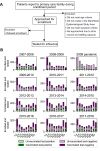






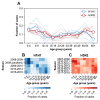











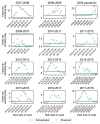


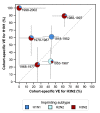


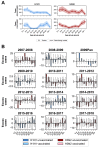
References
-
- Arevalo P, McLean HQ, Belongia EA, Cobey S. Data and code from: Earliest infections predict the age distribution of seasonal influenza A cases. c9f6d85GitHub. 2019 https://github.com/cobeylab/FluAImprinting - PMC - PubMed
-
- Arriola CS, Brammer L, Epperson S, Blanton L, Kniss K, Mustaquim D, Steffens C, Dhara R, Leon M, Perez A, Chaves SS, Katz J, Wallis T, Villanueva J, Xu X, Abd Elal AI, Gubareva L, Cox N, Finelli L, Bresee J, Jhung M, Centers for Disease Control and Prevention (CDC) Update: influenza activity - united states, September 29, 2013-february 8, 2014. MMWR. Morbidity and Mortality Weekly Report. 2014;63:148–154. - PMC - PubMed
-
- Beauté J, Zucs P, Korsun N, Bragstad K, Enouf V, Kossyvakis A, Griškevičius A, Olinger CM, Meijer A, Guiomar R, Prosenc K, Staroňová E, Delgado C, Brytting M, Broberg E, European Influenza Surveillance Network Age-specific differences in influenza virus type and subtype distribution in the 2012/2013 season in 12 european countries. Epidemiology and Infection. 2015;143:2950–2958. doi: 10.1017/S0950268814003422. - DOI - PMC - PubMed
-
- Bedford T, Riley S, Barr IG, Broor S, Chadha M, Cox NJ, Daniels RS, Gunasekaran CP, Hurt AC, Kelso A, Klimov A, Lewis NS, Li X, McCauley JW, Odagiri T, Potdar V, Rambaut A, Shu Y, Skepner E, Smith DJ, Suchard MA, Tashiro M, Wang D, Xu X, Lemey P, Russell CA. Global circulation patterns of seasonal influenza viruses vary with antigenic drift. Nature. 2015;523:217–220. doi: 10.1038/nature14460. - DOI - PMC - PubMed
Publication types
MeSH terms
Substances
Grants and funding
LinkOut - more resources
Full Text Sources
Medical

